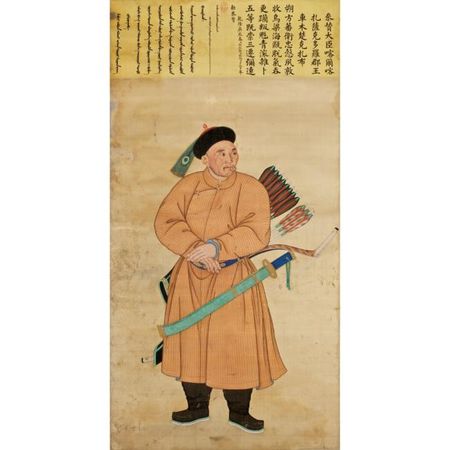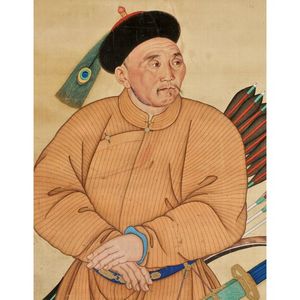An extremely rare and important imperial court painting of the bannerman Cemcukjab attributed to Ai Qimeng and Jin Tingbiao
An extremely rare and important imperial court painting of the bannerman Cemcukjab attributed to Ai Qimeng (Ignaz Sichelbart) (1708-1780) and Jin Tingbiao (Fl. 1757-1767). Qing dynasty, Qianlong period, dated to 1760. Photo Sotheby's
hanging scroll, ink and colour on silk
portraying the commanding officer of the northern borders of the Qing empire, with a distinguished war-weathered face, donning a fur-lined hat marked by a red glass bead and a peacock feather with a single-eyed plume, danyan hualing, dressed in a beige striped robe over black silk boots with white soles, his left hand resting atop the right hand at his waist, his belt securing his ceremonial sword concealed in a green shagreen sheath, his buffalo horn bow slung over his back along with a quiver of arrows with two types of fletching, all below a eulogy with several lines of text written on the right side in Chinese in kaishu (standard script) and in Manchu on the left, with one seal of the Qianlong Emperor, Qianlong Yulan Zhi bao; 151.5 by 95 cm., 60 3/8 by 37 3/8 in. Estimate 5,000,000—6,000,000 HKD. Lot Sold 7,220,000 HKD (925,641 USD) to an Asian Private
PROVENANCE: Acquired in Germany.
EXHIBITED: Die Bilder für die Halle des Purpurglanzes: Chinesische Offiziersporträts und Schlachtenkupfer der Ära Qianlong (1736-1795), Museum für Ostasiatische Kunst, Berlin, 2003, cat. no. 4.
LITERATURE AND REFERENCES: Charles R. Bawden, 'The Mongolian rebellion of 1756-1757'. Journal of Asian History 2. 1968, pp. 1–31.
Hartmut Walravens, 'New material on the portraits of meritorious officers of the Qianlong campaigns', Historical and Linguistic Interaction Between Inner-Asia and Europe, Szeged, Hungary, 1997 (Studia uralo-altaica 39), pp. 401–423.
Nie Chongzheng, Tan Ziguangge Gongchuan Xiang ['A discussion about the meritorious officers paintings of Ziguangge' (Hall of Purple Splendour)], Beijing, Zijincheng, 156.2008, pp. 138–169, esp. 151–152.
NOTE: This painting shows Cemcukjab (d. 1776), a commanding offficer of the northern borders of the Qing Empire, whom the eulogy describes as a meritorious officer of loyal and upright character who played a pivotal role in bringing peace to the area of Urianghai by completely subduing the robbers and capturing the rebel-chief Cinggunzab alive. For his bravery and military ability he was granted special favours and made a Prince of the second degree.
The translation from Manchu reads:
The councilor to the government, the Manchu Prince second degree, Kalka-Jasak Cemcukjab.
He was the protector and shield of the North, always demonstrating loyal and upstanding character, largely bringing peace to the area of Urianghai by completely subdueing the wicked and evil robbers.
He took the rebels by surprise, captured the heinous robber Cinggunzab [in Mongolian: Činggüncab] alive, after which he was granted special favor and made a prince of the second degree.
He was altogether promoted thrice, in quick succession.
In [gengchen] 1760 the officials Liu Tongxun , Liu Lun and Yu Minzhong received the imperial command to respectfully compose this eulogy.
Bannerman Cemcukjab distinguished himself in the Eastern Turkestan campaign (Xinjiang 1755-59), one of the major victorious campaigns of the Qianlong emperor where he sought to control the Dzungar state and secure the boundaries of Chinese Turkestan. This campaign helped eliminate Dzungar rivalry for control over the Dalai Lamas in Tibet and led to the pacification of the Islamicised, Turkic-speaking southern half of Xinjiang, thereby securing Qing imperial control over the vast region of Inner-Asia.
The present portrait is the sixth painting from the second series of bannerman paintings created in 1760. The eulogies of the second series of portraits were composed and written by the eminent officials Liu Tongxun, Liu Lun and Yu Minzhong. The painting shows Cemcukjab in his prime wearing a light brown striped surcoat and a single-eyed peacock feather attached to the back of his black fur-trimmed winter hat, an imperial gift bestowed only to officers who had distinguished themselves in a military campaign. His naturalistically rendered weathered face is depicted in three-quarter view, which is characteristic of this type of traditional Chinese portrait painting. The thick ink brushstrokes outlining the body and the vivid palette are typical of the painting style of the imperial academy of the 18th-century. A close look at the face reveals the influence of Western painting techniques introduced by Jesuit missionary artists at the Qing court. The modelling of the face is intense and naturalistic, especially in the eyes that are painted with white specks.
It is interesting to note that while professionally cleaning this painting, it was discovered that the figure's name was inscribed on the silk beneath the face. This supports the theory that the court artists painted the body, while the faces were left to the Jesuits to paint. In order not to wrongly match up heads and figures the person's name was written in the place where the face was to be later inserted.
For further information on bannerman paintings see Nie Chongzhen, 'The Newly Discovered Bannerman Painting of Yisamu from Ziguang Pavilion', Imperial Peking. The Last Days, Sotheby's, London, 2007, pp. 112-3. Various such paintings have been sold in our rooms; see a painting of the Bannerman Zha Er Shan, from the same series as the present one, sold in London, 13th May 2009, lot 136; and another of the Bannerman Yisamu, attributed to Ai Qimeng and Jin Tingbao, sold in Hong Kong, 9th October 2007, lot 1314, together with portraits of Bannerman Tanibu, lot 1315 and Bannerman Dalhan, lot 1316.
Further bannerman portraits include that of Hu Er Cha Ba, sold in New York, 3rd June 1986, lot 90; of the General Fu Heng, also sold in New York, 23-25th April 1987, lot 56; and a set of ten paintings from a handscroll of fifty paintings of bannermen by Jin Tingbao, also commissioned by the Qianlong emperor in 1769, again in New York, 31st March – 1st April 2005, lot 280. A group of bust-size oil paintings can be found in the Museum fur Volkerkunde, Staatliche Museen in Berlin, illustrated in Herbert Butz et al., Bilder fur die 'Halle des Purpurglanzes'; Berlin, 2004, pls 12-17.
Imperial bannerman paintings were housed in the Ziguange (Hall of Purple Splendour), a hall of fame for immortalised heroes, located in the West Garden of the Imperial Palace precincts in Beijing.
Sotheby's. Vestiges from China's Imperial History, 08 Apr 11, Hong Kong www.sothebys.com

/https%3A%2F%2Fprofilepics.canalblog.com%2Fprofilepics%2F1%2F0%2F100183.jpg)
/https%3A%2F%2Fstorage.canalblog.com%2F03%2F02%2F119589%2F96711876_o.jpg)
/https%3A%2F%2Fstorage.canalblog.com%2F11%2F31%2F119589%2F94773502_o.jpg)
/https%3A%2F%2Fstorage.canalblog.com%2F20%2F83%2F119589%2F94772815_o.jpg)
/https%3A%2F%2Fstorage.canalblog.com%2F26%2F72%2F119589%2F75604929_o.jpg)
/https%3A%2F%2Fstorage.canalblog.com%2F59%2F60%2F119589%2F26458628_o.jpg)





/http%3A%2F%2Fstorage.canalblog.com%2F98%2F98%2F119589%2F129097971_o.jpg)
/http%3A%2F%2Fstorage.canalblog.com%2F93%2F75%2F119589%2F128489120_o.jpg)
/http%3A%2F%2Fstorage.canalblog.com%2F09%2F29%2F119589%2F128488304_o.jpg)
/http%3A%2F%2Fstorage.canalblog.com%2F62%2F18%2F119589%2F128488091_o.jpg)